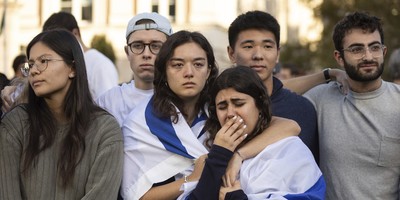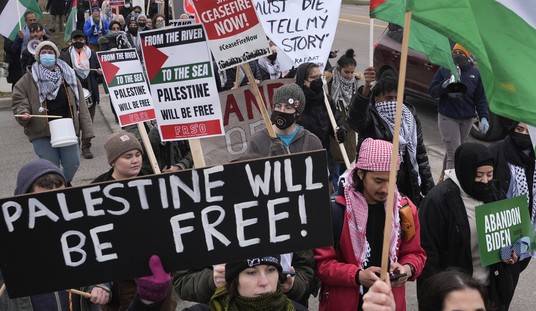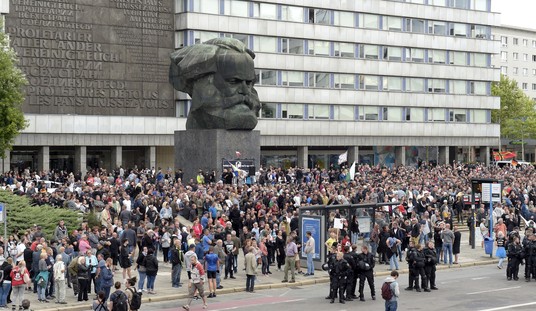The raging controversy over an exhibition of “gay art” at the taxpayer-funded National Portrait Gallery raises an uncomfortable but unavoidable question: must all celebrations of homosexual history and identity feature disturbing and pornographic content?
The show in question, “Hide and Seek: Difference and Desire in American Portraiture,” has drawn criticism from Republican congressional leaders for the inclusion of a video called “A Fire in My Belly” that includes imagery of Christ on the cross with ants crawling over and into his bloody wounds. Though museum officials agreed to remove this one outrageous item, other works in the display featured transvestitism, fetishism, sado-masochism, photographs of AIDS-ravaged corpses, full frontal male nudity, and other elements not readily associated with a national shrine in the nation’s capital best known for its displays of iconic portraits of American presidents.
While defenders of the “Hide and Seek” show describe all critics of the chosen art as bigoted and homophobic, the exhibit itself makes a crucial and revealing point about the essential nature of gay “pride”. Controversy surrounding the display has centered on the handful of outrageous items that deliberately cross boundaries of taste and decency, while most of the featured art has drawn no objection or unfavorable comment.
The exhibition, for instance, features handsome photographic portraits of celebrated gay figures from American history (including poet Walt Whitman and ballet impresario Lincoln Kirstein); universally admired paintings by Thomas Eakins and George Bellows of athletic young men displaying their well-muscled bodies; Georgia O’Keefe haunting renditions of horns and antlers; Marsden Hartley’s emotionally charged collage paintings, and other worthy items that might appear in any major gallery in the country. The richness of this material, in fact, makes it all the more perplexing that the curators for this much-publicized holiday season show should feel the need to include items like the (now removed) ant-crawling Jesus; a photograph of two nude, muscular brothers engaging in an erotic kiss; an S & M gay couple in black leather fetish gear, complete with bullwhips; or an assemblage that mixed the ashes of a suicidal AIDS victim with nail polish to create the impression of “Charles Devouring Himself.” Another photograph features the hideously grotesque dead body of yet another AIDS victim, staring accusingly at the camera, grotesquely laid out on garish pillows and blankets, surrounded by “his favorite things,” including “his TV remote control and his cigarettes.”
Recommended
In other words, the “Hide and Seek” Exhibit actually confirms the idea that any comprehensive consideration of “gay art” must give pride of place to sexually charged, sadistic, voyeuristic, nightmarish, and self-destructive themes. Visitors to the National Portrait Gallery, might wander from historic paintings of statesmen, inventors, writers and popular heroes of the last 200 years, to the museum’s first show honoring homosexual history would immediately discover a huge graphically realistic painting (by the controversial Larry Rivers) of a male hustler flaunting his genitals, or photos of bearded, bare-chested body-builders in chains.
In the midst of the current same-sex marriage debate, gay right advocates insist that homosexual and heterosexual couples are virtually indistinguishable, and that same sex desire constitutes as normal and positive a force in our society as the attraction between males and females. “Hide and Seek: Difference and Desire in American Portraiture” powerfully and definitively rebuts that notion.
Had the museum assembled a series of art works to highlight heterosexual “desire” there might have been a few erotic works showing strippers or courtesans, but it’s hard to imagine all the dark visions of sadism, domination and death currently featured at the National Portrait Gallery.
By the same token, Gay Pride parades around the country always celebrate bizarre displays of black leather, cross-dressing, fetishism, semi-nude dancing, masochism, and lurid costumes. While leaders of the homosexual community frequently stress family values, middle class stability, and gay identity as no more peculiar than any ethnic affirmation, that community’s big public festivals convey a very different message.
By the same token, the selection of art works in the ambitious exhibition at the august, publicly funded National Portrait Gallery should offend gay activists who seek to mainstream homosexual identity just as much as it outrages cultural conservatives. Those activists want to convey the idea that gay history and culture count as comparably substantive, decent, wholesome, constructive and admirable as the background and values of any other subgroup in America. Unfortunately, current art show in the nation’s capital serves to undermine rather than to reinforce that claim.

























Join the conversation as a VIP Member